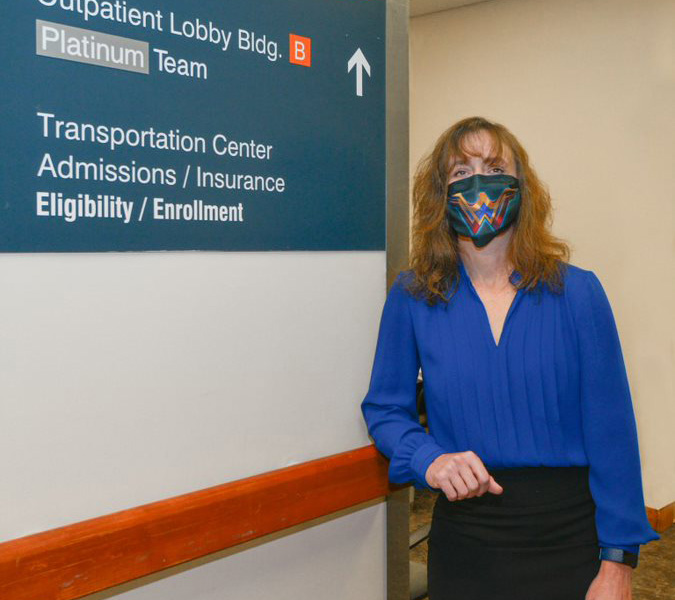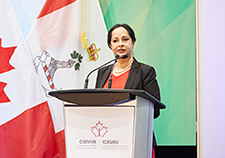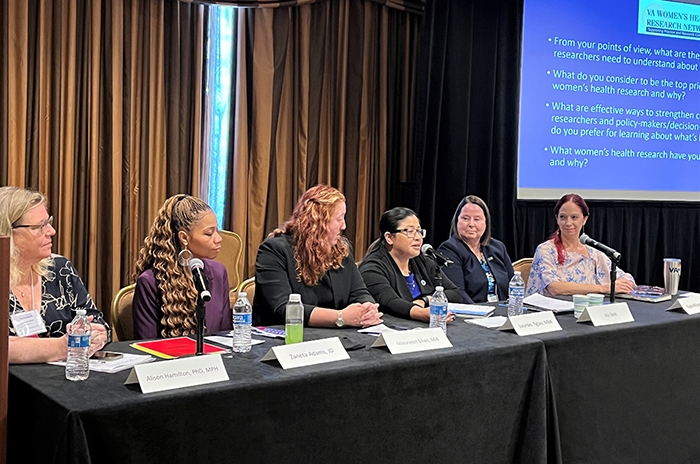Office of Research & Development |
 |
Office of Research & Development |
 |


Dr. Sheila Rauch is leading research on treating PTSD patients with the psychotherapy prolonged exposure for primary care at the Atlanta VA Health Care System. The Platinum Team is part of primary care at the Atlanta VA. (Photo by Joey Rodgers)
January 19, 2021
By Mike Richman
VA Research Communications
"Getting patients with PTSD to the most effective method of PTSD treatment quickly can increase their chance of engaging in and completing a successful episode of care."
Dr. Sheila Rauch is a VA leader in PTSD treatment and the director of mental health research and program evaluation at the Atlanta VA Health Care System. For more than two decades, she’s been training providers in VA, the Department of Defense, and the civilian sector in models for treating patients with PTSD.
One of those models is called prolonged exposure for primary care.

Million Veteran Program director speaks at international forum

2023 VA Women's Health Research Conference

Self-harm is underrecognized in Gulf War Veterans

Head trauma, PTSD may increase genetic variant's impact on Alzheimer's risk
Prolonged exposure is one of the premier trauma-focused, cognitive-behavioral therapies used in VA for patients with PTSD. It often requires referral to a mental health clinic and is based on someone thinking about the traumatic events he or she has experienced—at a time everything is fine—to help them realize those memories are not harmful and that people can do things they want to do with less fear. Case in point: Being in a crowded area where you can’t see people behind you may trigger anxious feelings, but it doesn’t mean something bad will happen.
Anger, guilt, sleep problems, and re-experiencing trauma through flashbacks and nightmares are common symptoms for Veterans with PTSD.
Prolonged exposure for primary care (PE-PC) uses essentially the same concepts in a briefer format, with a less demanding in-session time commitment (four to eight 30-minute sessions versus 8 to 15 90-minute sessions). Plus, all of the treatment is done in a primary care setting.
In Rauch’s view, many patients with PTSD who are referred to mental health services will not follow up, for one, because of the stigma that exists with going to mental health clinics. The time commitment also deters many people from taking part in the traditional form of prolonged exposure, she says. She thus supports use of prolonged exposure for primary care on a wider scale in VA, noting that 155 providers are now trained to administer it.
Major declines in PTSD symptoms
Following a clinical trial that showed PE-PC is more effective at reducing PTSD symptoms than weekly phone check-ins with a provider, Rauch led a small study that focused on how that treatment works in a VA primary care mental health setting. The study included 18 patients at the Atlanta VA, 16 of whom completed the treatment protocol: four to eight 30-minute sessions. Two-thirds of the sample met the full criteria for PTSD at entry. The rest did not but had PTSD symptoms they wanted to address in primary care. The participants attended five sessions on average.
The results showed major declines in PTSD symptoms from the first to the last treatment session, according to the PCL-5 checklist, a self-report measure that is used in health care to assess the 20 most commonly recognized PTSD symptoms. The research, published online in the journal Cognitive and Behavioral Practice in October 2020, included two case studies that provided “compelling evidence” the treatment helps reduce PTSD symptoms. The case studies are representative of the overall results, according to the researchers.
One of the case studies focused on a 70-year-old Army Veteran. His wife reported that he was “different” after returning from Vietnam in that he was irritable, drank more often, told of nightmares, and was reluctant to socialize with friends. In the study, he participated in six sessions and completed his homework. His symptoms significantly decreased, with no flashbacks after the first two weeks of treatment and no nightmares after the third.
The other case study involved a 35-year-old Marine Veteran who served three combat tours in Iraq. He said he was experiencing work-related stress and problems with irritability and sleep due to nightmares, in addition to other PTSD symptoms. He also tried to avoid large crowds.
He participated in six sessions and experienced “notable PTSD and depression symptom reduction, though he still met PTSD criteria in the mild range” at the end of the treatment protocol, the researchers write. “The therapist reviewed how he can use the skills of PE-PC on his own in the future to address other situations and memories and also reviewed how he can access additional care with PE-PC or through specialty mental health if he desires that in the future,” they say.
Currently, Rauch is leading a larger study that is examining functional outcomes in Veterans with PTSD who receive PE-PC, compared to those who receive standard PTSD treatment in primary care. She spoke with VA Research Currents about prolonged exposure for primary care.
VA Research Currents: What exactly is prolonged exposure for primary care and why is it necessary?
Rauch: Prolonged exposure for primary care is a brief version of the front-line PTSD treatment prolonged exposure. It provides treatment to patients with significant PTSD symptoms that they want to address in a primary care setting. Although it calls for fewer and shorter sessions, it is still a demanding treatment, as we ask patients to approach their worst fears. They also work a lot in between sessions by writing and reading about their traumatic memories. Most people with PTSD will never seek care for PTSD, and even those who do are unlikely to receive a first-line treatment, such as prolonged exposure or cognitive processing therapy. Providing this brief but effective treatment in primary care, where most people with psychological difficulties will receive their mental health care, can greatly increase access to effective PTSD care. More complicated cases call for specialty mental health services or people starting on certain medications who can later be managed in primary care.
Your study indicates that prolonged exposure for primary care is not intended to replace any front-line mental health treatments but instead provide a more accessible and less resource-intensive tool for effective use in primary care. Thus, other than calling for fewer and shorter sessions, does PE-PC differ from any of the first-line psychotherapies in any other way?
Prolonged exposure for primary care includes all of the components of full PE in a smaller dose, including psychoeducation, exposure (in vivo and imaginal), and processing. Psychoeducation includes learning about PTSD and how treatment works. Exposure means approaching the trauma memory or memories, as well as people, places, and-or things that remind you of your trauma. This is accomplished by writing out the trauma memory and gradually approaching the people, places, and-or things that remind you of the trauma. Processing is reviewing the meaning of the trauma and thoughts about yourself and others that came out of the trauma experience. The difference with full prolonged exposure is that the sessions are shorter, and the patient does more work between sessions with direction from the provider. For patients who are short on motivation or have major co-occurring health conditions, the flexibility of specialty mental health to provide more support to address multiple issues may be a better fit. But starting with PE-PC may be enough. Alternatively, PE-PC may help people accept and follow through on referrals to specialty care.
What are the origins of your involvement with prolonged exposure for primary care?
I was at the VA Ann Arbor Healthcare System in Michigan from 2005 to 2015. Dr. Jeffrey Cigrang reached out to me based on my work on PTSD treatment and primary care mental health to develop a treatment for use in primary care with active-duty military personnel with PTSD. Once we developed the program and demonstrated effectiveness in a pilot study, I started expanding to provide training to VA providers who had been asking to use this with their Veterans in primary care. When I moved in 2015 to the Atlanta VA, which had a large and thriving primary care mental health program but no specific brief PTSD-focused programs, many of the providers were interested to learn about this new model: prolonged exposure for primary care. To meet this provider and Veteran need, I pursued funding to support training providers in prolonged exposure for primary care.
How can a Veteran decide whether to pursue prolonged exposure for primary care, before advancing to a psychotherapy in a mental health setting?
That decision is an excellent discussion for patients and providers to have in a collaborative care model. If the patient wants to start in primary care, that is an excellent option. Getting patients with PTSD to the most effective method of PTSD treatment quickly can increase their chance of engaging in and completing a successful episode of care.
Can you address the role that stigma plays in deterring patients from getting treated for PTSD?
Mental health stigma is negative ideas that people have about those who suffer from mental health issues, such as they are weak or broken or that their PTSD cannot be cured. Stigma for mental health is prominent in VA and civilian settings. People put value judgements on their reactions and the reactions of others. Sometimes, people will not seek care because they think their issues are not as bad as others, and they feel guilty for seeking care. Others do not seek care because it makes them feel weak or vulnerable. Providing treatment in primary care can sidestep this stigma for some patients in that it doesn’t require a full diagnosis so long as there are PTSD symptoms that the patient wants to address. Plus, the brief nature of the program allows for quick treatment that may feel more comfortable for some patients. The program is also very patient-directed, meaning most of the work is done at home with direction from the provider, and the sessions are outside of a specialty mental health clinic.
Does prolonged exposure for primary care have the potential to be used on a wider scale in VA?
Definitely. Providing an option for briefer treatment allows more patients to be treated by the same number of specialist PTSD providers, with only the patients who need or want more sessions getting transitioned to specialty mental health. For instance, a PTSD specialty provider can treat three Veterans in 30-minute sessions in primary care in the same time required for one session of the full 90-minute protocol. The number of sessions is also less. PE-PC is best implemented as part of a system of care that includes efficient referral to specialty mental health for those who need more than the brief protocol.
How popular is prolonged exposure for primary care in non-VA settings?
Since most of our funding has been within VA and DOD, only a few of my civilian collaborators have been using prolonged exposure for primary care. But results have been promising. I now have civilian collaborators who are moving PE-PC into practice in California, Michigan, Tennessee, Minnesota, Oregon, Texas, and even South Africa.
VA Research Currents archives || Sign up for VA Research updates